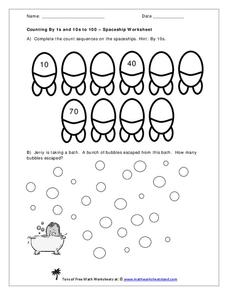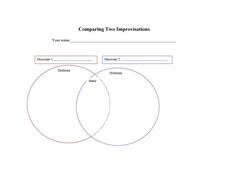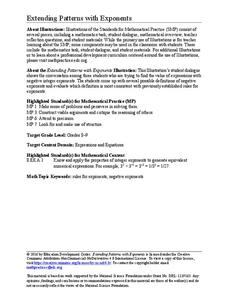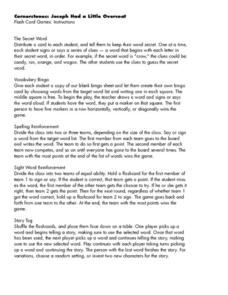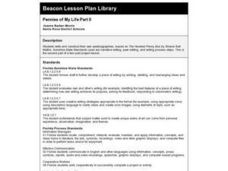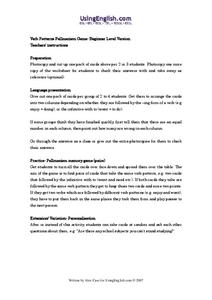Curated OER
Two Sides, Same Coin: How Political Beliefs Influence Language Use
Learners read several magazine articles on the same topic written from different political perspectives, paying particular attention to the diction, syntax, and arguments presented in support the point of view expressed. They then select...
Curated OER
Counting Practice
Young counters practice their skills in these two visual problems. First, they examine a number sequence beginning at 10 with a few filled in. They must count by 10s to fill in the rest of the pattern. Next, learners count the bubbles...
Curated OER
Comparing Two Improvisations
Jazz improvisation can be difficult to listen to for some music enthusiasts, however there are patterns and characteristics that can be analyzed. They use this Venn diagram to aid them in comparing two improvisational pieces, where they...
Curated OER
Counting by 1s Puzzle Worksheet
This dog is apparently quite upset that he is separated from his bone; can your learners use their counting skills to guide him back to it? The hundreds chart just took a fun twist! Scholars start at one on the bottom of the...
Curated OER
Hands Up Math
Learners engage in a instructional activity that is concerned with the concept of using all four operations in order to create numerical expressions. They practice creating various patterns of problems that could be solved. The...
DK Publishing
10 Times Table
Can scholars find the pattern as they multiply by 10? Third graders learn the beauty of number patterns as they shade in each multiple of ten in a hundreds chart. They complete 10 number sentences multiplying 10 by the numbers 1-10 (one...
EngageNY
Why Do Banks Pay YOU to Provide Their Services?
How does a bank make money? That is the question at the based of a lesson that explores the methods banks use to calculate interest. Groups compare the linear simple interest pattern with the exponential compound interest pattern.
Education Development Center
Extending Patterns with Exponents
Don't think negatively about exponents. Young mathematicians dissect a fictional conversation between pupils trying to evaluate an expression with a negative exponent. This allows them to understand the meaning of negative exponents.
Noyce Foundation
Between the Lines
Explore linear and square dimensions by comparing areas of similar figures. A creative set of five activities designed for elementary through high school classes asks young scholars to compare areas of specific polygons. The first two...
Willow Tree
Arithmetic and Geometric Sequences
Old mathematicians never die; they just lose some of their functions. Studying sequences gives scholars an opportunity to use a new notation. Learners write functions to model arithmetic and geometric sequences and use them to find new...
CK-12 Foundation
Multiplying Polynomials
Help your class find patterns in polynomial multiplication. Pupils multiply a trinomial by a binomial using a graphic organizer. They respond to questions about patterns observed in polynomial multiplication before a discussion question...
Education Development Center
Integer Combinations—Postage Stamps Problem (MS Version)
Number patterns can seem mysterious. Help your learners unravel these mysteries as they complete an intriguing task. Through examination, collaborative groups determine that they are able to produce all integers above a certain...
Contemporary Arts Center
Mughal Miniature Paintings: Pattern Transformations
What is the artist's role in the post 9/11 world? How do artists use imagery to convey meaning in their work? After examining the work of Mughal artist Imran Qureshi, class members create their own work that uses combative imagery to...
Curated OER
Get On Board
Students create a ticket table illustrating the cost of tickets by alternative transportation. In this number sense lesson, students write number sentences to compare and contrast difference information in their chart. Students figure...
CK-12 Foundation
Combination Problems: Friends at a Party
Friend or stranger? Can there be less than three in a group? The interactive asks learners to prove that for seven people at a party, at least three of them are either mutual friends or mutual strangers. Pupils determine the number of...
Kiddie Matters
Goal Setting Worksheet for Children
A one-page worksheet gives scholars the opportunity to list three goals and how they plan to accomplish them. Three questions challenge learners to reflect on their goals.
PBS
Joseph Had a Little Overcoat: Flash Card Games
Expand the vocabulary of young readers with this series of five activities based the children's book Joseph Had a Little Overcoat by Simms Taback. From playing bingo to group storytelling, a variety of different approaches are...
Kelly's Kindergarten
May Daily Activities
Five weeks of daily activities for the month of May! With a new activity for each day of the month, your youngsters will utilize a variety of skills and practice everything from sight words and spelling to counting by twos or coloring...
Curated OER
Pennies of My Life Part II
Youngsters write and construct their own autobiographies based on The Hundred Penny Box by Sharon Bell Mathis. They engage in pre-writing steps, narrative writing, and peer editing. This is the second part of a two-part project...
Math Stars
Math Stars: a Problem-Solving Newsletter Grade 7
Put on your thinking caps because middle school math has never been more interesting in this huge resource full of thought provoking questions. Written as a newsletter, the resource has 10 two-page newsletters with a variety of...
Curated OER
Red, White, and Blue Fun
Students cut out red, white, and blue stars and create different patterns with them. For this patterns lesson, students can make stamp patterns, number patterns, color patterns, and more!
Curated OER
The Difference of Two Squares
Learners practice the use of number properties through exploring the difference of two squares, creating an array model for multiplication, and work with decimal numbers. In groups, students explore patterns in an array and determine...
Curated OER
Design Patterns in Everyday Life
Students find symbols and patterns in everyday life. In this patterns lesson, students break into groups and look for specific patterns and symbols. Students record their findings. Students create a graphic organizer with the information.
Curated OER
Verb Patterns Pellmanism Game
Students identify verb patterns. In this grammar lesson, students participate in a game similar to memory. Students focus on the -ing ending.
Other popular searches
- Geometric Number Patterns
- Extending Number Patterns
- Fibonacci Number Patterns
- Math Number Patterns
- Number Patterns Worksheets
- Odd and Even Number Patterns
- Number Patterns in Math
- Ab Number Patterns
- Looking for Number Patterns
- Recognizing Number Patterns
- Number Patterns and Sequences
- Patterns Hundred Chart

